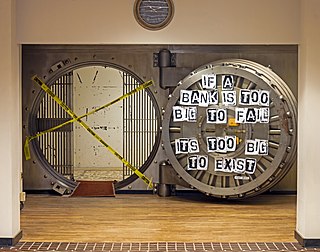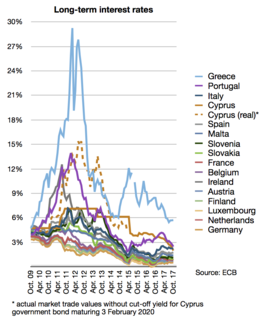
Fractional-reserve banking is the common practice by commercial banks of accepting deposits, and making loans or investments, while holding reserves at least equal to a fraction of the bank's deposit liabilities. Reserves are held as currency in the bank, or as balances in the bank's accounts at the central bank. Fractional-reserve banking is the current form of banking practiced in most countries worldwide.

Full-reserve banking is a proposed alternative to fractional-reserve banking in which banks would be required to keep the full amount of each depositor's funds in cash, ready for immediate withdrawal on demand. Funds deposited by customers in demand deposit accounts would not be loaned out by the bank because it would be legally required to retain the full deposit to satisfy potential demand for payments. Proposals for such systems generally do not place such restrictions on deposits that are not payable on demand, for example time deposits.

A lender of last resort (LOLR) is the institution in a financial system that acts as the provider of liquidity to a financial institution which finds itself unable to obtain sufficient liquidity in the interbank lending market and other facilities or sources have been exhausted. It is, in effect, a government guarantee of liquidity to financial institutions. Since the beginning of the 20th century, most central banks have been providers of lender of last resort facilities, and their functions usually also include ensuring liquidity in the financial market in general. The objective is to prevent economic disruption as a result of financial panics and bank runs spreading from one bank to the next from a lack of liquidity in one. Different definitions of the lender of last resort exist in literature. A comprehensive one is that it is "the discretionary provision of liquidity to a financial institution by the central bank in reaction to an adverse shock which causes an abnormal increase in demand for liquidity which cannot be met from an alternative source".
A bailout is a colloquial term for the provision of financial help to a corporation or country which otherwise would be on the brink of failure or bankruptcy.
A currency crisis is a situation in which serious doubt exists as to whether a country's central bank has sufficient foreign exchange reserves to maintain the country's fixed exchange rate. The crisis is often accompanied by a speculative attack in the foreign exchange market. A currency crisis results from chronic balance of payments deficits, and thus is also called a balance of payments crisis. Often such a crisis culminates in a devaluation of the currency.

Financial contagion refers to "the spread of market disturbances – mostly on the downside – from one country to the other, a process observed through co-movements in exchange rates, stock prices, sovereign spreads, and capital flows". Financial contagion can be a potential risk for countries who are trying to integrate their financial system with international financial markets and institutions. It helps explain an economic crisis extending across neighboring countries, or even regions.

Hyman Philip Minsky was an American economist, a professor of economics at Washington University in St. Louis, and a distinguished scholar at the Levy Economics Institute of Bard College. His research attempted to provide an understanding and explanation of the characteristics of financial crises, which he attributed to swings in a potentially fragile financial system. Minsky is sometimes described as a post-Keynesian economist because, in the Keynesian tradition, he supported some government intervention in financial markets, opposed some of the financial deregulation policies popular in the 1980s, stressed the importance of the Federal Reserve as a lender of last resort and argued against the over-accumulation of private debt in the financial markets.

The "too big to fail" theory asserts that certain corporations, particularly financial institutions, are so large and so interconnected that their failure would be disastrous to the greater economic system, and that they therefore must be supported by government when they face potential failure. The colloquial term "too big to fail" was popularized by U.S. Congressman Stewart McKinney in a 1984 Congressional hearing, discussing the Federal Deposit Insurance Corporation's intervention with Continental Illinois. The term had previously been used occasionally in the press.
The United States subprime mortgage crisis was a nationwide financial crisis, occurring between 2007 and 2010, that contributed to the U.S. recession of December 2007 – June 2009. It was triggered by a large decline in home prices after the collapse of a housing bubble, leading to mortgage delinquencies and foreclosures and the devaluation of housing-related securities. Declines in residential investment preceded the recession and were followed by reductions in household spending and then business investment. Spending reductions were more significant in areas with a combination of high household debt and larger housing price declines.
A flight-to-quality, or flight-to-safety, is a financial market phenomenon occurring when investors sell what they perceive to be higher-risk investments and purchase safer investments, such as US treasuries or gold. This is considered a sign of fear in the marketplace, as investors seek less risk in exchange for lower profits.
In financial economics, a liquidity crisis refers to an acute shortage of liquidity. Liquidity may refer to market liquidity, funding liquidity, or accounting liquidity. Additionally, some economists define a market to be liquid if it can absorb "liquidity trades" without large changes in price. This shortage of liquidity could reflect a fall in asset prices below their long run fundamental price, deterioration in external financing conditions, reduction in the number of market participants, or simply difficulty in trading assets.
A credit crunch is a sudden reduction in the general availability of loans or a sudden tightening of the conditions required to obtain a loan from banks. A credit crunch generally involves a reduction in the availability of credit independent of a rise in official interest rates. In such situations, the relationship between credit availability and interest rates changes. Credit becomes less available at any given official interest rate, or there ceases to be a clear relationship between interest rates and credit availability. Many times, a credit crunch is accompanied by a flight to quality by lenders and investors, as they seek less risky investments.
This article provides background information regarding the subprime mortgage crisis. It discusses subprime lending, foreclosures, risk types, and mechanisms through which various entities involved were affected by the crisis.
The Emergency Economic Stabilization Act of 2008, commonly referred to as a bailout of the U.S. financial system, is a law enacted subsequently to the subprime mortgage crisis authorizing the United States Secretary of the Treasury to spend up to $700 billion to purchase distressed assets, especially mortgage-backed securities, and supply cash directly to banks. The funds for purchase of distressed assets were mostly redirected to inject capital into banks and other financial institutions while the Treasury continued to examine the usefulness of targeted asset purchases. Both foreign and domestic banks are included in the program. The Act was proposed by Treasury Secretary Henry Paulson during the global financial crisis of 2008 and signed into law by President George W. Bush on October 3, 2008.
The U.S. subprime mortgage crisis was a set of events and conditions that led to a financial crisis and subsequent recession that began in 2007. It was characterized by a rise in subprime mortgage delinquencies and foreclosures, and the resulting decline of securities backed by said mortgages. Several major financial institutions collapsed in September 2008, with significant disruption in the flow of credit to businesses and consumers and the onset of a severe global recession.
The Subprime mortgage crisis solutions debate discusses various actions and proposals by economists, government officials, journalists, and business leaders to address the subprime mortgage crisis and broader financial crisis of 2007–08.

The financial crisis of 2007–2008, also known as the global financial crisis and the 2008 financial crisis, is considered by many economists to have been the most serious financial crisis since the Great Depression of the 1930s.

The European debt crisis is an ongoing financial crisis that has made it difficult or impossible for some countries in the euro area to repay or re-finance their government debt without the assistance of third parties.








